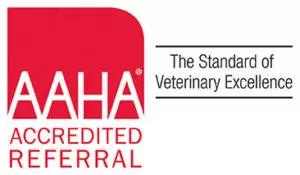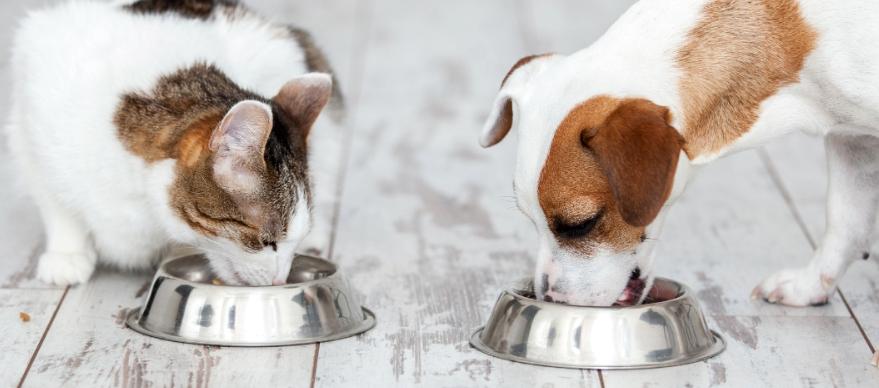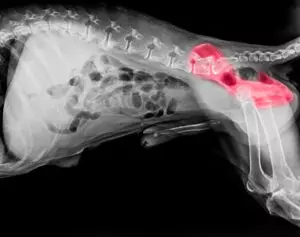Category: Blog
Motion Palpation and Veterinary Medical Manipulation
Orthopedic conditions are common in pets, but structural changes seen on X-rays and other imaging modalities often don’t correlate with the patient’s signs. When a pet’s joint range of motion is restricted, significant repercussions, including neck or back pain, lameness, organ dysfunction, and a reduced immune response, can result. Veterinarians qualified in motion palpation and Veterinary Medical Manipulation (VMM) techniques can help restricted pets regain healthy joint movement and reduce their muscle tension, alleviate pain, strengthen muscles, and re-nourish cartilage and nerve tissue.
What is motion palpation in veterinary medicine?
Motion palpation involves a veterinarian’s hands-on examination of every vertebral junction for functional changes, with the veterinarian taking each joint through its entire range of motion to detect motion loss or increased resistance to induced motion. Potential spinal segmental dysfunction issues, or restrictions, include:
- Symmetrical or asymmetrical joint mobility loss in one or more planes
- Localized pain
- Increased pain when pressure is applied to surrounding muscles and bony structures
- Active inflammation or chronic tissue changes, such as swelling, tissue thickening, redness, and altered surface temperature, that can be visualized or palpated
In many cases, joints with segmental dysfunction issues appear completely normal when viewed on X-rays or other diagnostic imaging techniques.
How do restrictions affect pets?
Restrictions have numerous consequences for pets, including:
- Local effects — Restrictions can cause tissue adhesions, joint cartilage degeneration, and decreased blood flow to the joint, and the mechanical stress, muscle tension, and inflammation can alter nerve function and be painful.
- Compensatory effects — Joints adjacent to the restricted joint become hyper-mobile to compensate, increasing their injury risk and their susceptibility to degenerative joint disease (i.e., arthritis). In addition, when surrounding muscles attempt to stabilize the hyper-mobile joint, they contract more than normal and become tense, which places more stress on tendons and increases injury risk.
- Systemic effects — Chronic pain and inflammation can lead to systemic effects, such as organ dysfunction and a weakened immune response.
What is Veterinary Medical Manipulation?
VMM is similar to human chiropractic care and involves correcting specific restrictions and restoring normal range of motion using a high velocity, low amplitude (HVLA) thrust in the joint’s plane. The veterinarian can perform these manipulations hands-on or with specialized instruments designed for pets.
What are the signs that my pet may benefit from Veterinary Medical Manipulation?
Signs that indicate your pet may benefit from VMM include:
- Neck or back pain
- Abnormal gait or undefined lameness
- Abnormal posture or stance
- Reduced performance
- Reluctance to move, jump, or climb stairs
- Stiffness
- Discomfort when being petted, groomed, or lifted
- Recurrent digestive problems or incontinence
- Recurrent infections
- Lick granulomas
Who performs Veterinary Medical Manipulation?
A thorough knowledge of structural anatomy, neurophysiology, and biomechanics, as well as spine and extremities pathologies, is critical for understanding VMM principles and applying the techniques appropriately. This means that veterinary and specific chiropractic training is essential. Motion palpation and VMM should be performed only by qualified veterinary professionals who have completed additional specialized animal chiropractic training and certification to ensure safe and effective treatment for animals.
What can I expect during my pet’s Veterinary Medical Manipulation appointment?
A typical initial VMM appointment begins with a thorough history and physical examination. Depending on your pet’s condition, the veterinarian may first recommend diagnostics, such as X-rays or blood work, and then perform a motion palpation examination, correcting the restrictions with VMM techniques. Most pets relax and show no pain or anxiety during these manipulations. Depending on your pet’s case, they may be sent home or remain in the hospital for overnight observation. Some pets respond quickly to treatment and need only one or two adjustments, while those with chronic conditions may benefit from regular VMM sessions. Your veterinarian will determine the best protocol for your pet.
VMM is often used in conjunction with other veterinary treatments, such as medication, surgery, acupuncture, physical rehabilitation, and food therapy. For more information about VMM and the Integrative Medicine services provided by Dr. Michel Selmer, contact Long Island Veterinary Specialists at (516) 501-1700, or visit us at livs.org.
Food Therapy
Hippocrates said, “Let food be thy medicine, and let medicine be thy food,” in 400 BC, indicating that for centuries people have realized nutrition was important to help prevent and cure disease. Food therapy is a component of Traditional Chinese Veterinary Medicine (TCVM) that uses specific foods and herbs to treat pets based on genetic tendencies, age, species, environment, disease patterns, personality, and stress levels. Food therapy does not simply involve recommending generally healthy foods, but rather prescribing particular foods based on the pet’s individual needs. Food therapy selects and combines the appropriate foods for your four-legged friend to restore and maintain their balance and optimal health.
Food therapy goals for pets
Food therapy’s purpose is to determine each pet’s distinct patterns and suggest ingredients that can benefit their individual needs and constitution. Food therapy recipes can be classified as follows:
- Health promotion and prevention — These diets are meant to improve health on an everyday basis and to prevent climate-related and seasonal problems.
- Disease treatment — These diets are formulated to complement primary treatments for clinical conditions, such as skin problems, autoimmune disease, otitis, cancer, kidney and liver disease, and immunodeficiency.
Food therapy is not meant to replace traditional medicine but to enhance conventional and integrative therapies.
Food therapy philosophy for pets
Food therapy is based on TCVM’s Five Element Theory, which takes a holistic approach to pets’ health and healing by organizing the body into five functioning organ systems that correspond with natural elements. Each element has unique properties that influence the digestive system and overall health and wellness. Foods are classified as cooling or warming in each of the five elements, which include:
- Water element — The water element governs the kidneys and bladder and includes foods that contain water to help cleanse and detoxify the body, flush out toxins, and hydrate cells.
- Warming water element foods include beef, lamb, chicken, and ginger.
- Cooling water element foods include cucumber, watermelon, mung bean, and cabbage.
- Wood element — The wood element governs the liver and gallbladder, which store and release bile to help break down fats.
- Warming wood element foods include oatmeal, brown rice, millet, and honey.
- Cooling wood element foods include celery, lettuce, broccoli, and sprouts.
- Fire element — The fire element governs the small intestine and heart and includes hot or spicy foods that help increase circulation and metabolism.
- Warming fire element foods include chili pepper, cinnamon, nutmeg, and cloves.
- Cooling fire element foods include watermelon, tomatoes, strawberries, and oranges.
- Earth element — The earth element governs the spleen and stomach, which are responsible for food digestion.
- Warming earth element foods include sweet potatoes, yams, peanuts, and sesame seeds.
- Cooling earth element foods include radishes, beets, and carrots.
- Metal element — The metal element governs the lungs and colon, which help control breathing and body fluid and waste removal.
- Warming metal element foods include pumpkin, squash, and ginger.
- Cooling metal element foods include pears, apples, bananas, and papaya.
Flavors can influence food therapy for pets
Your pet can receive therapeutic benefits from different flavors, such as:
- Bitter — Bitter foods cool down the body and direct energy downward, helping to reduce inflammation.
- Sweet — Sweet foods nourish bodily fluids and aid digestion. Processed sugars create internal heat and inflammation and lead to conditions such as obesity and diabetes, while healthy sweet foods such as Chinese yams can help boost energy levels and aid digestion.
- Spicy — Spicy foods can help with moving energy outward and with treatment of respiratory issues.
- Salty — Salty foods, which help cool the body and move energy inward, help improve thyroid function.
- Sour — Sour foods can help with GI issues, such as diarrhea.
Seasonal influence on food therapy for pets
Food choices should be balanced and modified with the season, especially in northern climates with dramatic seasonal changes. Considerations include:
- Spring and summer — Spring and summer foods should help your pet reduce and dispel heat and stay hydrated.
- Fall and winter — Fall and winter foods should help keep your pet warm, but not stimulate inflammation.
Temperature and color can influence food therapy for pets
A food’s temperature and color can also influence their effect on the body. Specifics include:
- Temperature — Warm foods help with digestion and circulation, while cool foods help calm the mind.
- Color — Different-colored foods target specific body areas that need attention. For example, black foods, such as blackberries and black beans, can help with kidney issues; yellow foods, such as ginger, squash, and yams, can aid digestion; and leafy green foods can minimize liver problems.
Food therapy combined with other treatment modalities can enhance your pet’s overall treatment effectiveness and help ensure an optimal outcome. If you would like to learn more about food therapy and the Integrative Medicine services provided by Dr. Michel Selmer, contact Long Island Veterinary Specialists at (516) 501-1700, or visit us at livs.org.








